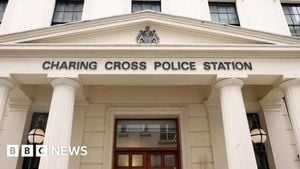In a dramatic turn of events, Hamas has agreed to key elements of a sweeping 20-point Gaza peace plan championed by former U.S. President Donald Trump, signaling a potential breakthrough in one of the world’s most intractable conflicts. The announcement, made on October 3, 2025, follows a tense week of high-stakes diplomacy, mounting international pressure, and a looming ultimatum from Trump that threatened to unleash "all hell" if a deal was not reached by Sunday evening.
The plan, unveiled on September 30, 2025, during Israeli Prime Minister Benjamin Netanyahu’s visit to the White House, lays out a roadmap for an immediate ceasefire, the release of hostages, a phased Israeli withdrawal from Gaza, and a new era of Palestinian self-governance. According to The Times of Israel and Al Jazeera, Hamas has agreed to the release of all remaining hostages "according to the exchange formula outlined in President Trump’s proposal, provided that the conditions necessary for the exchange are secured." This includes the return of both living hostages and the remains of those deceased, though senior Hamas official Mousa Abu Marzouk cautioned that the process would take longer than the 72-hour window stipulated in the plan due to "current circumstances."
Trump, never one to shy away from public pronouncements, took to his social media platform Truth Social to declare, "I believe they are ready for lasting PEACE." He also urged Israel to "immediately stop the bombing of Gaza, so that we can get the Hostages out safely and quickly!" The former president’s tone was both congratulatory and stern, warning Hamas that if they did not seize the opportunity, "all bets will be off." As Reuters reported, Trump thanked Israel for temporarily halting its military campaign to allow negotiations to proceed, but insisted, "I will not tolerate delay, which many think will happen, or any outcome where Gaza poses a threat again. Let’s get this done, FAST. Everyone will be treated fairly!"
The 20-point plan itself is ambitious and, if enacted, would represent a seismic shift in the region’s political landscape. Its provisions call for Israel to immediately cease all military operations in Gaza and, upon agreement, to withdraw its forces to lines agreed upon for the purpose of facilitating the hostage release. During this period, all military activity would be suspended. Within 72 hours of Israel’s public acceptance, all hostages—alive and dead—would be returned, while Israel would release 250 prisoners serving life sentences and 1,700 Gazans detained after the October 7, 2025, Hamas attacks.
Crucially, the plan stipulates that Hamas members who commit to peaceful existence and surrender their weapons will be granted amnesty, and those wishing to leave Gaza would be given safe passage. Full humanitarian aid would be delivered to Gaza immediately, with distribution overseen by the United Nations and the Red Crescent, free from interference by either party. Gaza’s governance during the transition would fall to a technocratic, apolitical Palestinian committee, supervised by an international body—the "Board of Peace"—chaired by Trump himself.
The plan does not stop at security and governance. It also envisions a massive economic redevelopment initiative, with a special economic zone and a panel of experts assembled to rebuild and energize Gaza. No one would be forced to leave; instead, the plan encourages residents to remain and participate in the creation of a "better Gaza." All Hamas infrastructure, including tunnels and weapons production sites, would be destroyed, and Hamas and other factions would have no role in Gaza’s future government.
Compliance would be guaranteed by regional partners, and the United States would work with Arab and international allies to deploy an International Stabilization Force (ISF) to Gaza. This force would train vetted Palestinian police and, as it established control, the Israeli Defense Forces would progressively withdraw according to demilitarization milestones agreed upon by all parties.
Should Hamas delay or reject the proposal, the plan outlines that humanitarian aid and redevelopment efforts would proceed in "terror-free areas" handed over from the IDF to the ISF. Additionally, the plan calls for the establishment of an interfaith dialogue process to foster tolerance and peaceful coexistence, with the long-term goal of creating conditions for credible Palestinian self-determination and statehood.
Despite the initial breakthrough, significant hurdles remain. Hamas has made it clear that while it is prepared to transfer power to a Palestinian governing body elected "based on Palestinian national consensus and with Arab and Islamic support," other aspects of the plan—particularly those relating to Gaza’s governance and Palestinian rights—require further negotiation. "These issues will be discussed in a unified Palestinian national framework in which Hamas will participate and contribute responsibly," the group said in its statement, as cited by BBC News.
Notably, Hamas’s willingness to relinquish its weapons—a key demand of the plan—marks a dramatic shift from its historical position, though skepticism lingers over whether the group will fully follow through. The plan’s stipulation that Hamas and all factions must forfeit any role in Gaza’s future government and destroy their infrastructure has been met with reservations from within the group’s ranks, as previously reported by Al Jazeera.
On the Israeli side, Prime Minister Netanyahu has expressed support for the immediate cessation of hostilities and the phased withdrawal, but he remains resolute in his opposition to a Palestinian state. "It's not written in the agreement. We said we would strongly oppose a Palestinian state," Netanyahu stated, according to Haaretz. This stance could complicate the plan’s final implementation, given that the proposal leaves open the door for eventual Palestinian self-determination and statehood—an outcome long sought by the Palestinians but fiercely resisted by many in Israel’s current leadership.
Meanwhile, the fate of the remaining hostages continues to hang in the balance. As of October 4, 2025, approximately 48 hostages are still believed to be held by Hamas, with 20 thought to be alive, according to The Guardian. The urgency to secure their release has added a layer of intensity to the negotiations, with families and advocacy groups on both sides anxiously awaiting concrete progress.
International reaction has been cautiously optimistic but tinged with skepticism. Regional powers, including Egypt and Qatar, have reportedly backed the framework, while the United Nations and the Red Crescent are preparing to oversee humanitarian operations should the plan move forward. Yet, as history has shown, even the most promising peace initiatives in the region have faltered over details, delays, and deep-seated mistrust.
For now, the eyes of the world are fixed on Gaza and the negotiating tables in Washington and the Middle East. Whether this plan will finally bring lasting peace or become another chapter in the region’s long saga of missed opportunities remains to be seen. But for the first time in months, the prospect of an end to the violence—and a new beginning for Gaza—feels within reach.






